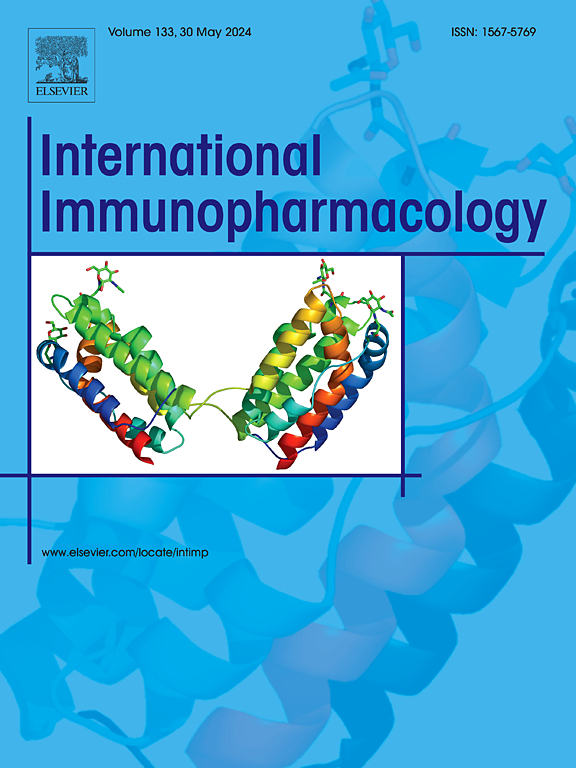eplerenone和非诺贝特对卵巢缺血再灌注损伤中TLR4/MYD88/ NF-κB/AP1/IL-6通路的免疫调节及醛固酮/PPARα受体的调节
IF 4.8
2区 医学
Q2 IMMUNOLOGY
引用次数: 0
摘要
免疫系统深入参与各种妇科疾病的发病机制,包括卵巢扭转,这种疾病通常发生在手术操作过程中或卵巢肿块内,不仅影响卵巢,而且对其他器官特别是心脏组织有远程影响。早期干预和适当的医学治疗对于保护卵巢和防止远处器官损伤是非常重要的。因此,本研究的目的是评估依普利酮(EPL)或非诺贝特(FEN)在卵巢缺血/再灌注(OIR)实验模型中对卵巢和心脏影响的可能改善作用。方法50只雌性Wistar白化大鼠随机分为5组(n = 10);对照组、OIR诱导组、OIR加EPL (100 mg/kg)、OIR加FEN (300 mg/kg)、OIR加EPL (100 mg/kg)加FEN (300 mg/kg)。结果soir可致卵巢损伤伴远端心脏损伤。目前的研究数据显示,心脏酶和丙二醛(MDA)水平显著增加,但总抗氧化能力(TAC)和谷胱甘肽(GSH)水平降低。此外,toll样受体4 (TLR4)、髓样分化primary response 88 (MYD88)、活化蛋白1 (AP1)、白细胞介素6 (IL-6)、核因子κ b (NF-κB)、cleaved caspase-3表达升高,组织学特征异常。然而,EPL或FEN单独或联合给药可通过拮抗EPL的醛固酮作用、抗炎、抗氧化和抗凋亡,通过FEN和TLR4/MYD88/ NF-κB/AP1/IL-6途径调节过氧化物酶体增殖物激活受体α (PPARα),逆转OIR损伤作用。有趣的是,两种药物联合使用比单独使用更有改善。结论epl和/或FEN对OIR诱导的有害影响具有改善作用。本文章由计算机程序翻译,如有差异,请以英文原文为准。
Immune regulation of TLR4/MYD88/ NF-κB/AP1/IL-6 pathway and modulation of aldosterone/PPARα receptors by eplerenone and fenofibrate in ovarian ischemia reperfusion induced injury
Background
The immune system is deeply involved in the pathogenesis of different gynecological disorders including ovarian torsion that commonly occurs during surgical manipulation or within ovarian masses, affecting not only the ovaries, but it has remote effect on different organs particularly cardiac tissue. Early intervention and proper medical treatment are so important to preserve the ovaries and prevent distant organ damage. Accordingly, the aim of this work was to evaluate the possible ameliorative role of eplerenone (EPL) or fenofibrate (FEN) on ovarian and cardiac affection in an experimental model of ovarian ischemia/reperfusion (OIR).
Method
Fifty female Wistar albino rats were divided into five groups (n = 10); control, OIR induced group, OIR plus EPL (100 mg/kg), OIR plus FEN (300 mg/kg), OIR plus EPL (100 mg/kg) plus FEN (300 mg/kg).
Results
OIR could induce ovarian injury with remote cardiac damage. Data of current study revealed significant increases of the cardiac enzymes, and malondialdehyde (MDA) levels but decreases of total anti-oxidant capacity (TAC) and reduced glutathione (GSH) levels. Moreover, there were increases in toll like receptor 4 (TLR4), myeloid differentiation primary response 88 (MYD88), activation protein 1 (AP1), interleukin 6 (IL-6), nuclear factor kappa b (NF-κB) and cleaved caspase-3 with abnormal histological features. However, EPL or FEN co-administration alone or in combination reversed OIR damaging effects by antagonizing aldosterone action by EPL, anti-inflammatory, anti-oxidant, and anti-apoptotic features with modulation of peroxisome proliferator activated receptor alpha (PPARα) by FEN and TLR4/MYD88/ NF-κB/AP1/IL-6 pathway. Interestingly, co-administration of both drugs showed more improvement than giving each one alone.
Conclusion
EPL and/or FEN had ameliorative properties against OIR induced harmful effects.
求助全文
通过发布文献求助,成功后即可免费获取论文全文。
去求助
来源期刊
CiteScore
8.40
自引率
3.60%
发文量
935
审稿时长
53 days
期刊介绍:
International Immunopharmacology is the primary vehicle for the publication of original research papers pertinent to the overlapping areas of immunology, pharmacology, cytokine biology, immunotherapy, immunopathology and immunotoxicology. Review articles that encompass these subjects are also welcome.
The subject material appropriate for submission includes:
• Clinical studies employing immunotherapy of any type including the use of: bacterial and chemical agents; thymic hormones, interferon, lymphokines, etc., in transplantation and diseases such as cancer, immunodeficiency, chronic infection and allergic, inflammatory or autoimmune disorders.
• Studies on the mechanisms of action of these agents for specific parameters of immune competence as well as the overall clinical state.
• Pre-clinical animal studies and in vitro studies on mechanisms of action with immunopotentiators, immunomodulators, immunoadjuvants and other pharmacological agents active on cells participating in immune or allergic responses.
• Pharmacological compounds, microbial products and toxicological agents that affect the lymphoid system, and their mechanisms of action.
• Agents that activate genes or modify transcription and translation within the immune response.
• Substances activated, generated, or released through immunologic or related pathways that are pharmacologically active.
• Production, function and regulation of cytokines and their receptors.
• Classical pharmacological studies on the effects of chemokines and bioactive factors released during immunological reactions.

 求助内容:
求助内容: 应助结果提醒方式:
应助结果提醒方式:


